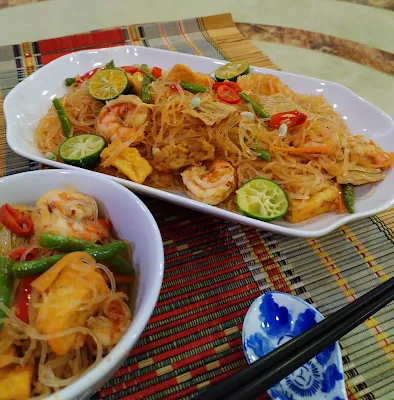Stir Fried Glass Noodles With Sambal And Tamarind Juice
Have you ever tried stir-fried glass
noodles with sambal? If you haven’t,
you’re in for a treat! This glass noodle stir fry is delicious and bursting
with flavors!
It is prepared with a range of ingredients. The combination of vegetables, protein, and carbohydrates. The vegetable that I am using is French bean. Besides, the dish also contains potatoes, tempeh, tofu, and tofu sheet. While the shrimp provides a protein-packed base. Makes it rather full even though eaten without rice. It is truly as satisfying as a one pot meal.
The secret to bringing all these
flavors together is the sambal which you may refer to Nasi Lemak Sambal about the
ingredients of making it. It’s spicy, savory, slightly sweet, and just a little
bit salty, with a rich umami flavor that’s hard to resist.
These glass noodles have a tangy taste
from the tamarind sauce in addition to the umami and spice from the sambal.
Although it can be slightly tart, the flavour of the tamarind is never overpowering.
It makes your lips pucker a little bit, but it goes well with any spicy meal.
You'll love these juice additions for sure.
The fresh flavor of just-squeezed lime
juice or calamansi juice, a balance of crunchy and chewy, the pungency of the sambal
flavor, and just enough heat to set your tongue tingling.
INGREDIENTS
1/2 cup Cooking Oil to cook the
sambal
Some cooking oil for frying
3 tbsp sambal
1/4 tbsp tamarind pulp, mix with 3
tbsp of water
½ cup Shrimp stock
1/4 tbsp sweet soy sauce
20 g Carrot, julienned
10 Prawns, cleaned and deveined
30g French Bean, cut
1/2 pkt tempeh, sliced and fried
1 pc hard tofu, sliced and fried
50g potato, cut into small pieces and
fried
25 g glass noodle, soaked until
soften
1/2 pc dried tofu sheet, soaked until
soften
1 mild red chili, sliced
METHOD
1. Heat some cooking oil, to fry the French
bean, potatoes, tempeh, and tofu. keep it aside.
2. Cook the sambal with ½ cup of cooking oil. Stir fry until fragrant.
3. Add in prawns, stir until prawns
are cooked. Add in julienned carrots, fried French beans, potatoes, tempeh, tofu, and tofu sheet. Give it good stir until all the ingredients are well coated with the
sambal sauce.
4. Add in the softened glass noodles,
tamarind paste juice and sweet soy sauce, and water. Toss to combine with the
sauce and vegetable mixture.
5. Continue cooking for 1-2 minutes
until the noodles have absorbed most of the sauce and are heated through. Add
in the sliced chilies, stir until well combined.
6. Transfer to a serving dish and squeeze
some lime or calamansi juice before serving.






Comments
Post a Comment